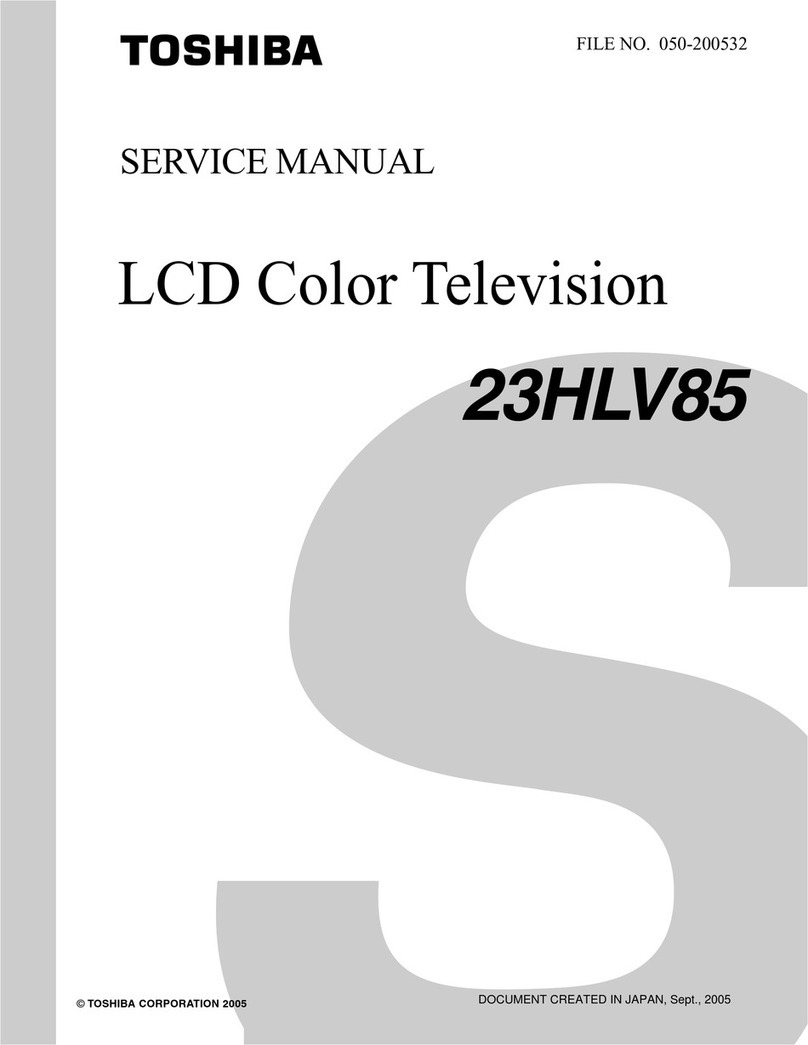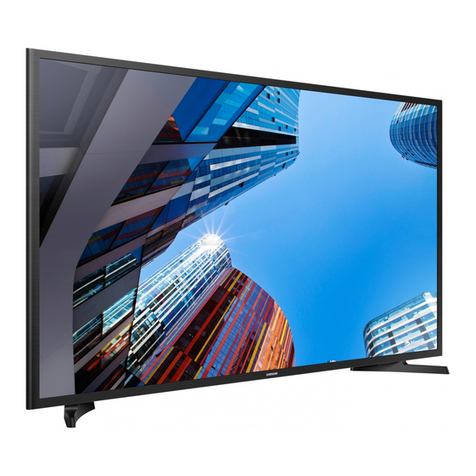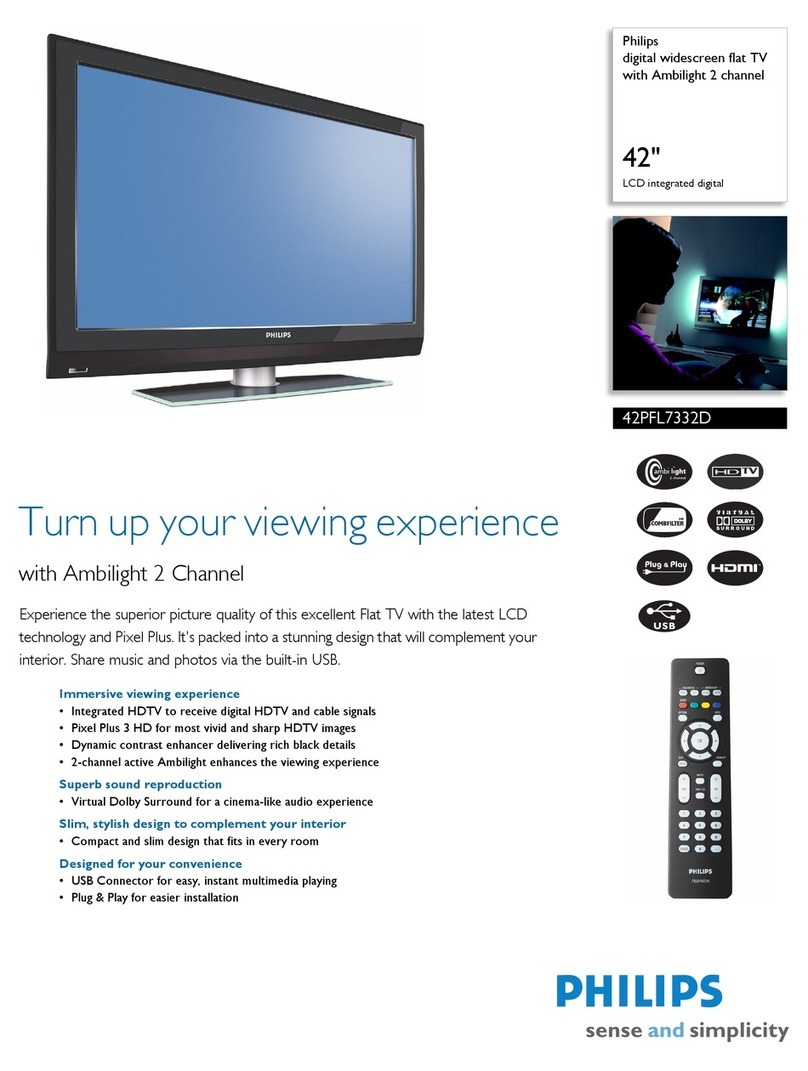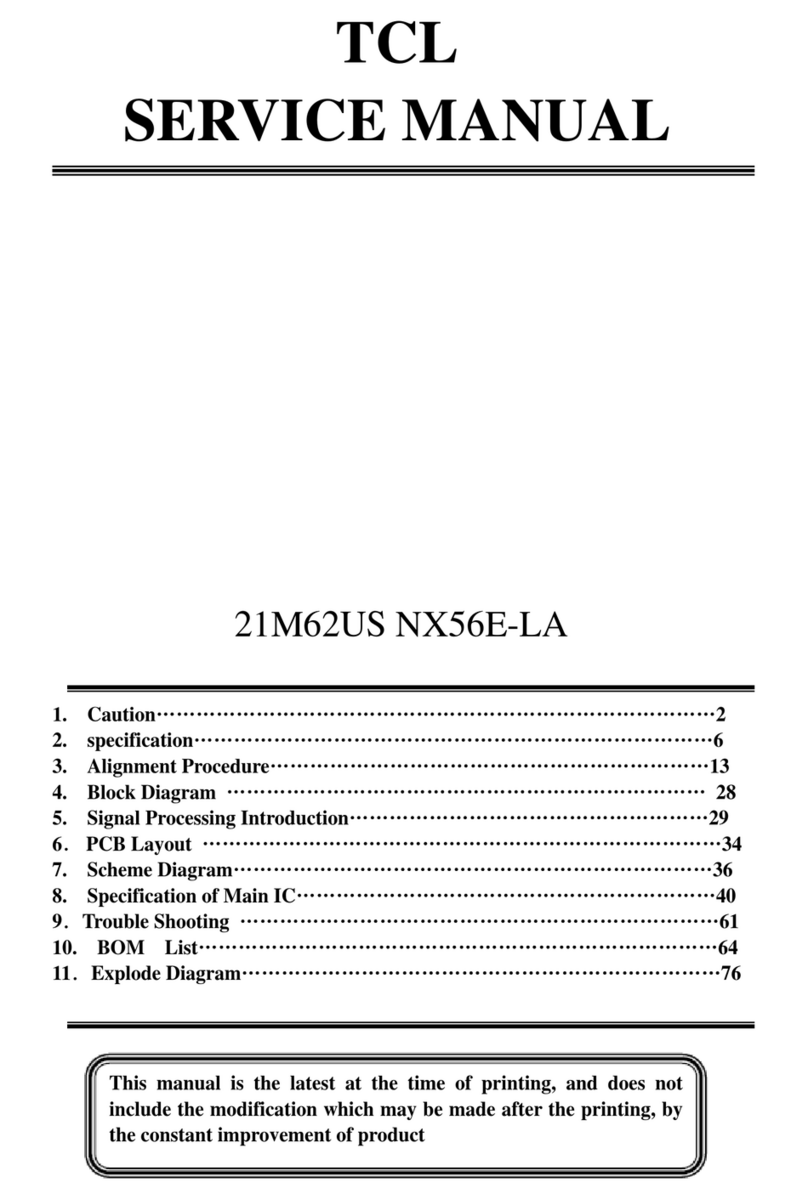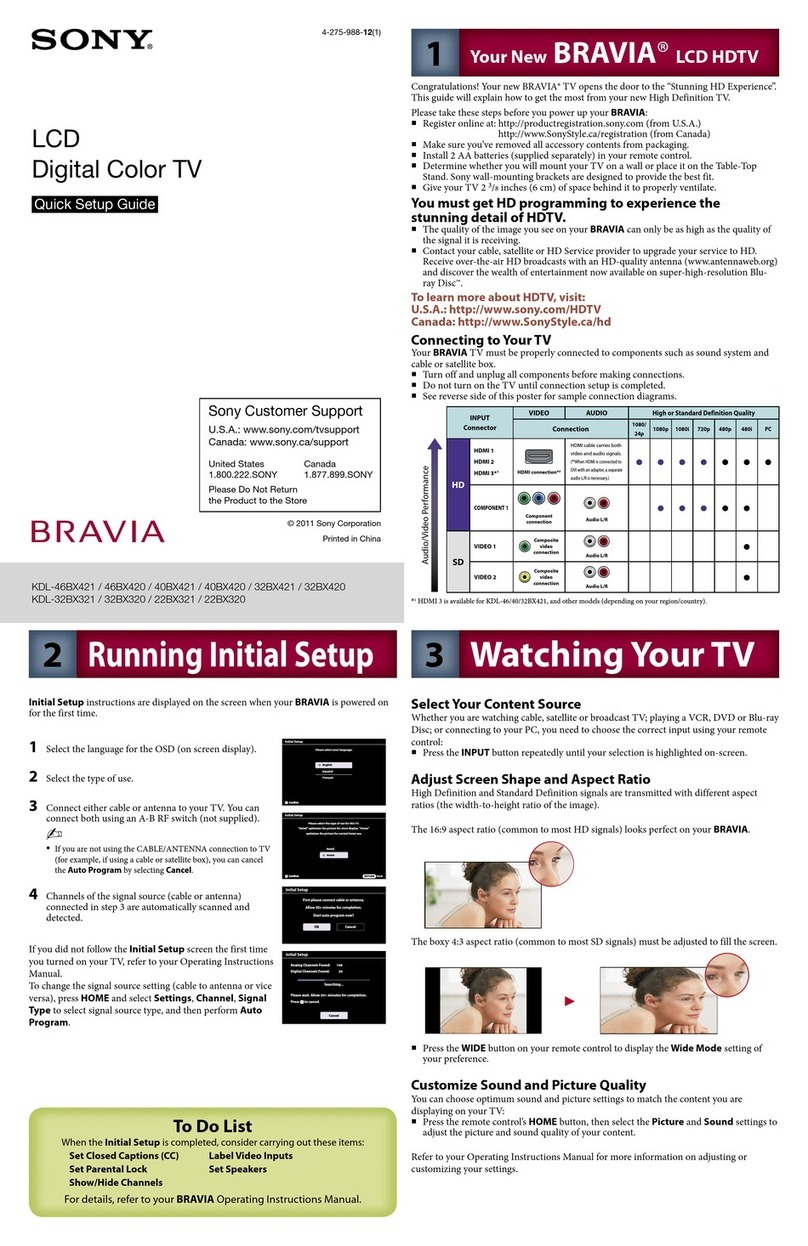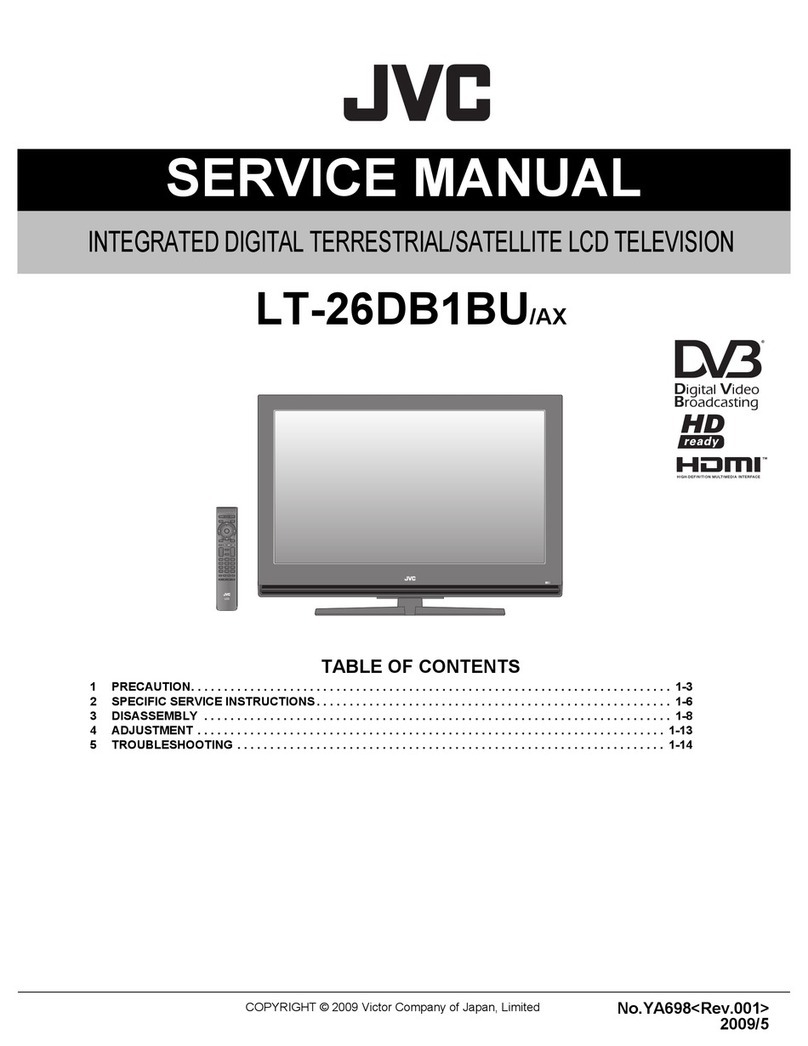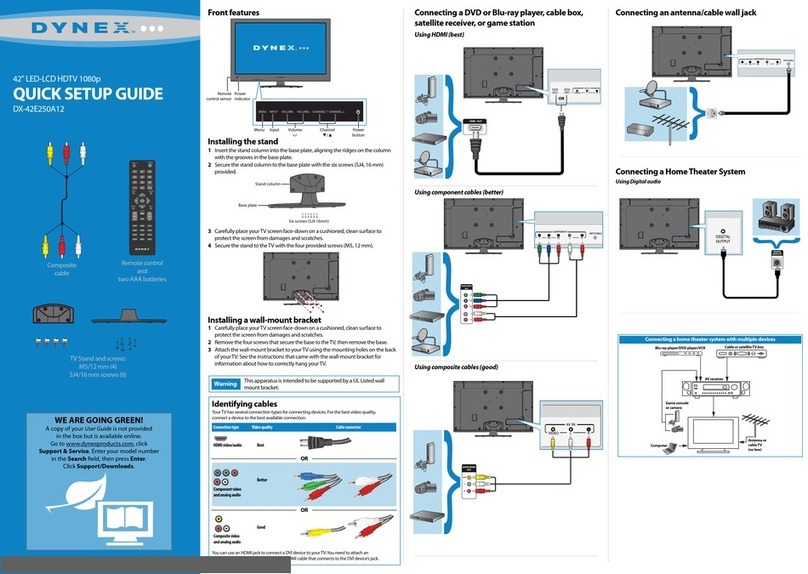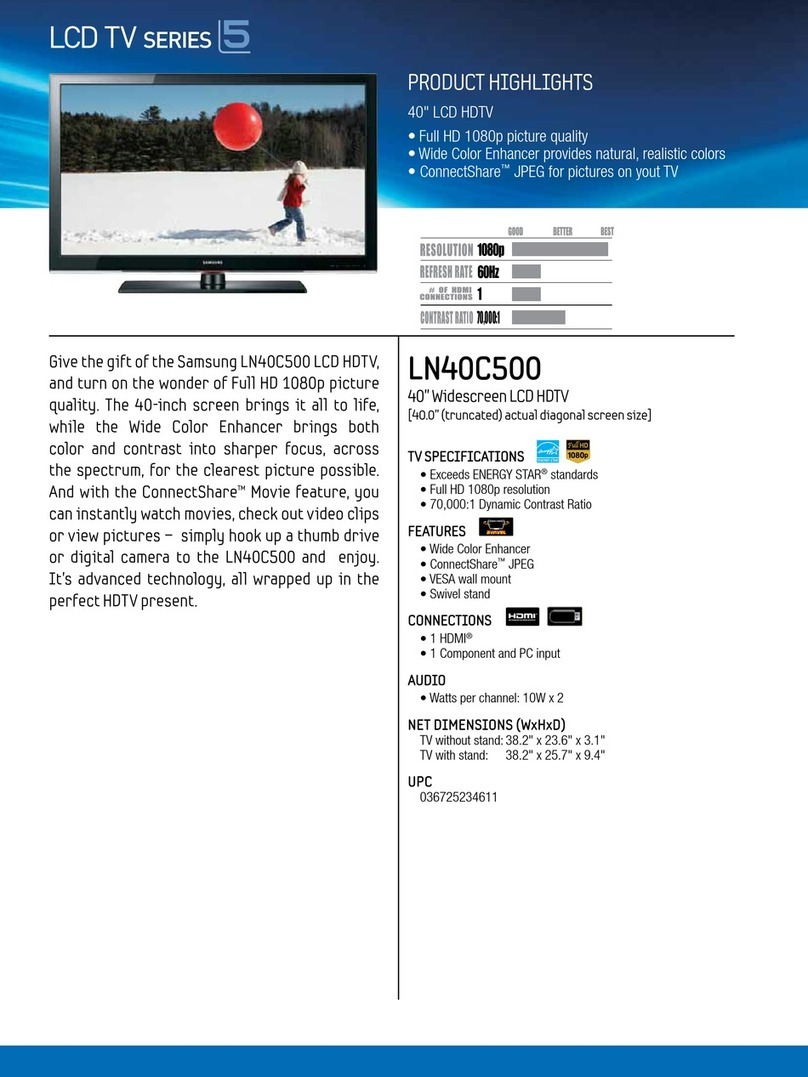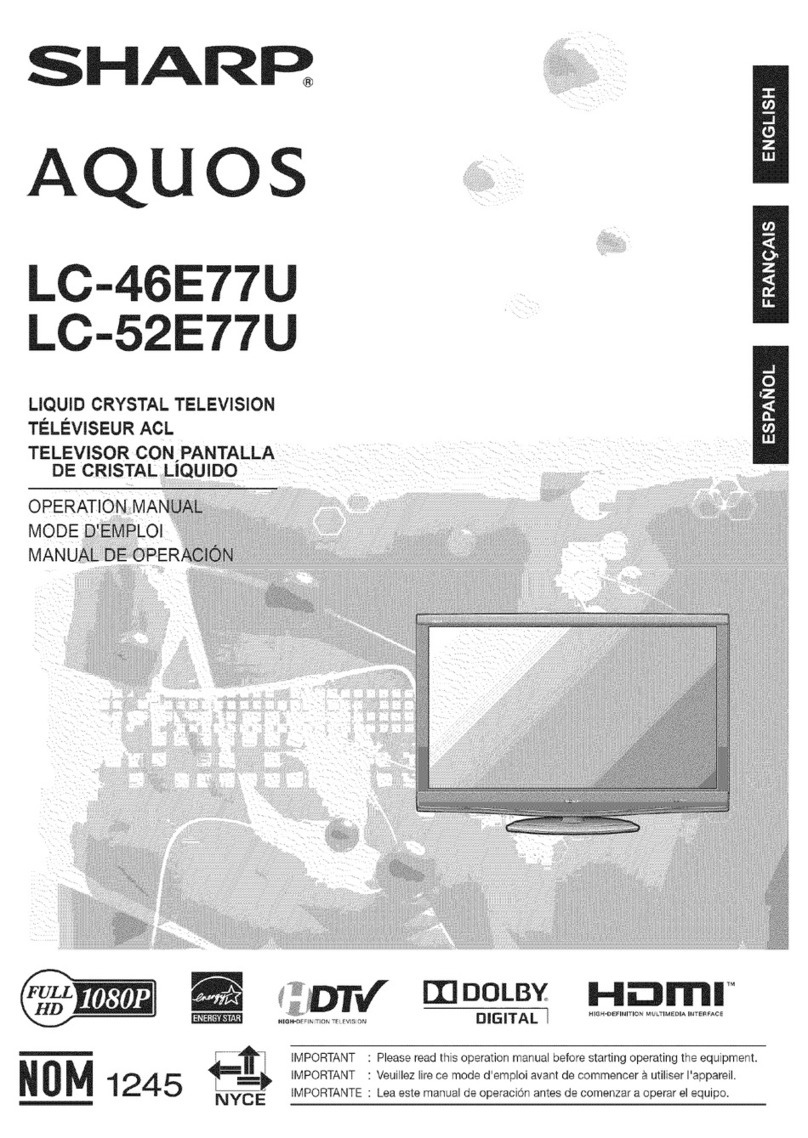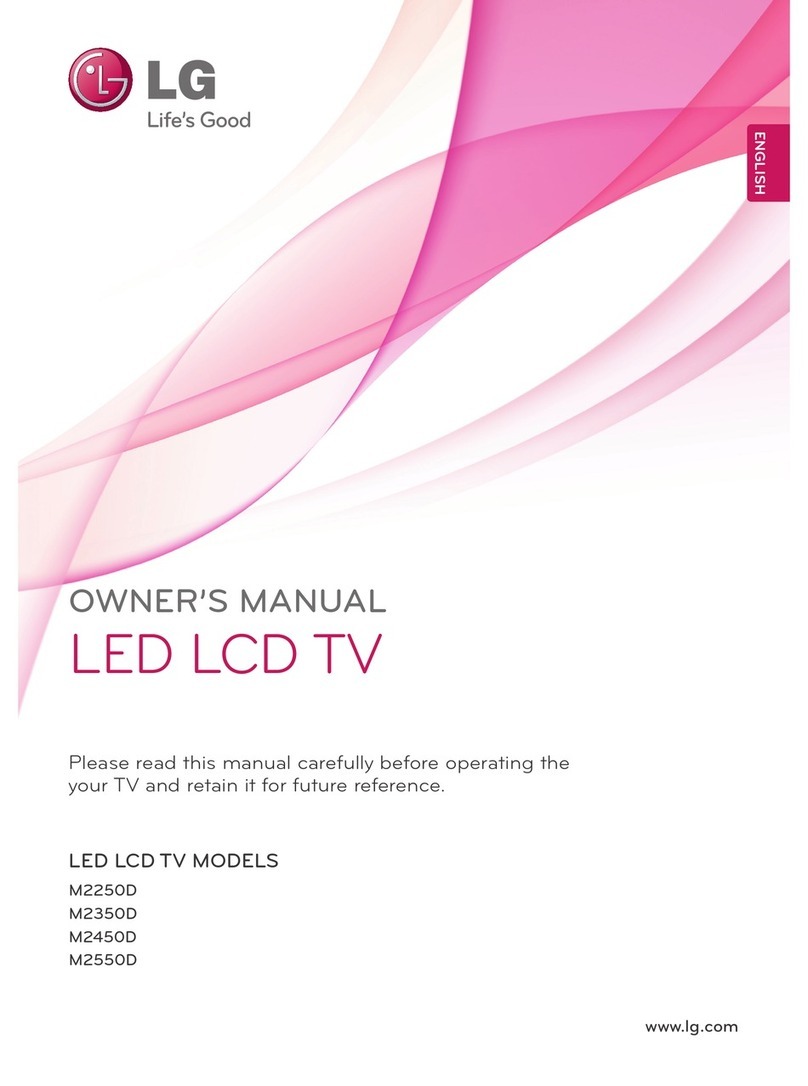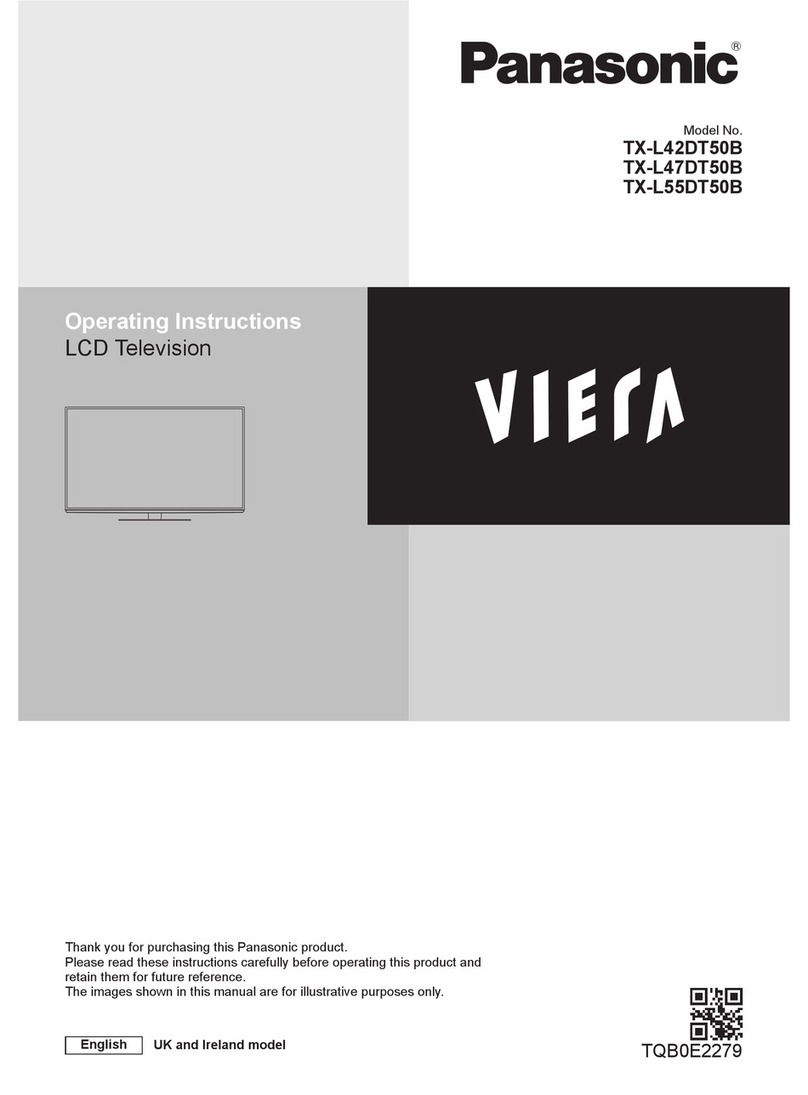Kreisen LT-30FMP User manual

Test Report No.: GETEC-E3-03-013
FCC Class B Certification
APPENDIX H
: USER’S MANUAL
EUT Type: 30” LCD TV/Monitor
FCC ID : QDBLT-30FMP

30” wide LCD Color TV
O
O
Ow
w
wn
n
ne
e
er
r
r’
’
’s
s
s
M
M
Ma
a
an
n
nu
u
ua
a
al
l
l
Model: LT-30FMP

2
Warnings
1
WARNING:
T
O REDUCE THE RISK OF ELECTRIC SHOCK DO NOT REMOVE COVER (OR BACK). NO USE
R
SERVICEABLE PARTS INSIDE. REFER SERVICING TO QUALIFIED SERVICE PERSONNEL.
The lightning flash with arrowhead symbol, within an equilateral triangle, is intended to aler
t
the user to the presence of uninsulated “dangerous voltage” within the product’s enclosure
that may be of sufficient magnitude to constitute a risk of electric shock to persons.
The exclamation point within an equilateral triangle is intended to alert the user to the
presence of important operating and maintenance (servicing) instructions in the literature
accom
p
an
y
in
g
the a
pp
liance.
WARNING:
TO PREVENT FIRE OR SHOCK HAZARD DO NOT EXPOSE THE SET TO RAIN OR MOISTURE.
NOTE TO CABLE/TV INSTALLER:
This reminder is provided to call the cable TV system installer’s attention to Article 820-40 of the
National Electric Code (U.S.A.). The code provides guidelines for proper grounding and, in particular,
specifies that the cable ground shall be connected to the grounding system of the building, as close to
the point of the cable entry as practical.
REGULATORY INFORMATION:
This equipment has been tested and found to comply with the limits for a Class B digital device,
pursuant to part 15 of the FCC Rules. These limits are designed to provide reasonable protection
against harmful interference when the equipment is operated in a residential Installation. This
equipment generates, uses and can radiate radio frequency energy and, if Not installed and used in
accordance with the instruction manual, may cause harmful interference to radio communications.
However, there is no guarantee that interference will not occur in a particular installation. If this
equipment does cause harmful interference to radio or television reception, which can be determined
by turning the equipment off and on, the user is encouraged to try to correct the interference by one
or more of the following measures:
• Reorient or relocate the receiving antenna.
• Increase the separation between the equipment and receiver.
• Connect the equipment into an outlet on a circuit different from that to which the receiver is
connected.
• Consult the dealer or an experienced radio/TV technician for help.
CAUTION:
Changes or modifications not expressly approved by the party responsible for compliance could void the
user's authority to operate the equipment.

3
IMPORTANT SAFETY INSTRUCTIONS
IMPORTANT SAFETY INSTRUCTIONS
Important safeguards for you and your new product
Your product has been manufactured and tested with your safety in mind. However, improper use can result
in potential electrical shock or fire hazards. To avoid defeating the safeguards that have been built into your
new product, please read and observe the following safety points when installing and using your new
product, and save them for future reference.
Observing the simple precautions discussed in this operating guide can help you get many years of
enjoyment and safe operation that are built into your new product.
This product complies with all applicable U.S. Federal regulations and voluntary safety standards.
1. Read Instructions
All the safety and operating instructions should be
read before the product is operated.
2. Follow Instructions
All operating and use instructions should e followed.
3. Retain Instructions
The safety and operating instructions should be
retained for future reference.
4. Heed Warnings
All warnings on the product and in the operating
instructions should be adhered to.
5. Cleaning
Unplug this product from the wall outlet before
cleaning. Do not use liquid cleaners or aerosol
cleaners. Use a damp cloth for cleaning.
6. Water and Moisture
Do not use this product near water for example, near
a bathtub, washbowl, kitchen sink, or laundry tub, in
a wet basement, or near a swimming pool.
7. Accessories, Carts, and Stands
Do not place this product on a slippery or tilted
surface, or on an unstable cart, stand, tripod,
bracket, or table. The product may slide or fall,
causing serious injury to a child or adult, and serious
damage to the product. Use only with a cart, stand,
tripod, bracket, or table recommended by the
manufacturer, or sold with the product. Any
mounting of the product should follow the
manufacturer’s instructions, and should use a
mounting accessory recommended by the
manufacturer.
8. Transporting Product
A product and cart combination should be moved
with care. Quick stops, excessive force, and uneven
surfaces may cause the product and cart
combination to overturn.
9. Attachments
Do not use attachments not recommended by the
product manufacturer as they may cause hazards.
10. Ventilation
Slots and openings in the cabinet are provided for
ventilation and to ensure reliable operation of the
product and to protect it from overheating, and
these openings must not be locked or covered. The
openings should never be blocked by placing the
product on a bed, sofa, rug, or other similar surface.
This product should not be placed in a built-in
installation such as a bookcase or rack unless proper
ventilation is provided or the manufacturer ’s
instructions have been adhered to.
11. Power Sources
This product should be operated only from the type
of power source indicated on the marking label. If
you are not sure of the type of power supply to your
home, consult your product dealer or local power
company. For products intended to operate from
battery power, or other sources, refer to the
operating instructions.
12. Power Cord Polarization
This product is equipped with a three-wire
grounding-type plug, a plug having a third
(grounding) pin This plug will only fit into a
grounding-type power outlet. . This is a safety
feature. If you are unable to insert the plug into the
outlet, contact your electrician to replace your
obsolete outlet. Do not defeat the safety purpose of
the grounding-type plug.
13. Power Cord Protection
Power-supply cords should be routed so that they
are not likely to be walked on or pinched by items
placed upon or against them, paying particular
attention to cords at plugs, convenience receptacles,
and the point where they exit from the product.

4
Important Safety Instructions
14. Outdoor Antenna Grounding
If an outside antenna or cable system is connected
to the product, be sure the antenna or cable system
is grounded so as to provide some protection against
voltage surges and built-up static charges. Article
810 of the National Electrical Code (U.S.A.),
ANSI/NFPA 70 provides information with regard to
proper grounding of the mast and supporting
structure, grounding of the lead-in wire to an
antenna discharge unit, size of grounding
conductors, location of antenna-discharge unit,
connection to grounding electrodes, and
requirements for the grounding electrode.
Example of Grounding According to National
Electrical Code Instructions
15. Lightning
For added protection for this product (receiver)
during a lightning storm, or when it is left
unattended and unused for long periods of time,
unplug it from the wall outlet and disconnect the
antenna or cable system. This will prevent damage
to the product due to lightning and power-line
surges.
16. Power Lines
An outside antenna system should not e located in
the vicinity of overhead power lines or other electric
light or power circuits, or where it can fall into such
power lines or circuits. When installing an outside
antenna system, extreme care should be taken to
keep from touching such power lines or circuits, as
contact with them might be fatal.
17. Overloading
Do not overload wall outlets and extension cords as
this can result in a risk of fire or electric shock.
18. Object and Liquid Entry
Never push objects of any kind into this product
through openings as they may touch dangerous
voltage points or short-out parts that could result in
a fire or electric shock. Never spill liquid of any kind
on the product.
19. Servicing
Do not attempt to service this product yourself as
opening or removing covers may expose you to
dangerous voltage or other hazards. Refer all
servicing to qualified service personnel.
20. Damage Requiring Service
Unplug this product from the wall outlet and refer
servicing to qualified service personnel under the
following conditions:
a. If the power-supply cord or plug is damaged.
b. If liquid has been spilled, or objects have
fallen into the product.
c. If the product has been exposed to rain or
water.
d. If the product does not operate normally by
following the operating instructions. Adjust
only those controls that are covered by the
operating instructions as an improper
adjustment of other controls may result in
damage and will often require extensive work
by a qualified technician to restore the
product to its normal operation.
e. If the product has been dropped or the
cabinet has been damaged.
f. If the product exhibits a distinct change in
performance.
21. Replacement Parts
When replacement parts are required, be sure the
service technician has used replacement parts
specified by the manufacturer or have the same
characteristics as the original part. Unauthorized
substitutions may result in fire, electric shock, or
other hazards.
22. Safety Check
Upon completion of any service or repairs to this
product, ask the service technician to perform
safety checks to determine that the product is in
proper operating condition.
23. Wall Mounting
The product should be mounted to a wall only as
recommended by the manufacturer. The product
may slide or fall, causing serious injury to a child or
adult, and serious damage to the product.
24. Heat
The product should be situated away from heat
sources such as radiators, heat registers, stoves, or
other products (including amplifiers) that produce
heat.

5
Contents
Before operating the set, please read this manual carefully.
Warnings 3
Important Safety Instruction 4-5
Contents 6
Supplied Accessories 7
Controls
Remote control handset
Controller of panel
8~10
Basic Operation
On and off
Channel selection
Volume adjustment
Q.View
Mute Function
On screen Language selection
11
On Screen Display 12
Setting up TV Channel
Auto Program
Manual Program
13-14
Parental control 15-17
Closed caption 18
Picture Control
Manual picture control
Auto picture control
19
Sound Control 20
Other functions
TV, COMPONENT, VIDEO and S-VIDEO mode
Auto sleep
Sleep timer
ST/SAP
PIP function
21-22
Connecting external equipment
Aerial socket
COMPONENT socket
A/V-IN socket
S-VIDEO socket
Headphone socket
23-24
Connecting PC as monitor 25-26
Connecting DTV 27
Product specifications 28
Troubleshooting 29
Limited warranty 30

6
Supplied Accessories
*Make sure the following accessories are provided with Product.
1. AC/DC adaptor
2. AC cord
3. Remote controller
4. Batteries (2ea, AAA type)
5. Ant. adaptor
6. Owner’s manual
7. PC analog IN cable
8. PC digital IN cable
9. PC Audio IN cable
Battery installation
▶Inserting batteries
1. Remove the battery cover by pulling it upward in the direction shown by the arrow.
2. Insert the batteries with correct polarity ( "+" to "+", and "-" to "-" ).
3. Replace the battery compartment cover.
* Install two high-quality 1.5V "AAA" alkaline batteries. Don't mix old batteries with new batteries.
*Remove batteries when you won't use the remote controller for long time. Liquid leakage from old batteries
may cause operation failure.
Notes for using remote controller
• Make sure there are no objects between the remote control and its sensor.
• Don't place the remote control near a heater or in damp place. Strong impact to the remote control may
cause operation failure.
• Signal from the remote control may be disturbed by sunlight or other bright light. In this case, darken the
room or move the TV.

7
Controls
1. POWER Switches TV set on or off.
2. MENU Displays a menu.
3. –CH+ (Channel Up/Down)
Selects a channel or a menu item.
4. –VOL+ (Volume Up/Down)
Adjusts the volume./ Adjusts menu settings.
5. TV/AV
Selects TV, COMPONENT, VIDEO, S-VIDEO or PC mode. / Clears the menu from the screen.
6. POWER STANDBY INDICATOR
Illuminates brightly when the TV is in standby mode. / Dims when the TV is switched on.
7. Remote control sensor Accepts the IR signal of remote controller.
6
5
2
1
3
4
7
1. DC 24V adaptor input
2. PC/DTV INPUT
3. DVI
4. PC Audio IN
Connect the audio cable from the PC to the PC Audio IN of the set.
5. HEADPHONE out
Connect a headphone to this socket.
6. S-VIDEO input
Connect the output of an S -VIDEO VCR to the S-VIDEO input.
Connect the audio outputs of an S-VIDEO VCR to the AV-IN audio inputs.
7. COMPONENT[VIDEO( Y, CB, CR), AUDIO(L(MONO), R)]
8. A/V-OUT
9. A/V-IN
Connect the Audio/Video outputs of external equipment to these inputs.
10. Ant. (Antenna input)

8
Controls
All the functions can be controlled with the remote controller. Some functions can also be adjusted with the
buttons on the front panel of the set.
Remote controller
Before you use the remote controller, please install the batteries.
1. POWER
Turns the TV on from standby or off to standby mode.
2. MUTE
Turns the sound on and off.
3. NUMBER buttons
Selects programme numbers.
4. PSM (Picture Status Memory)
Recalls your preferred picture setting
5. SSM (Sound Status Memory)
Recalls your preferred sound setting
8. TV/AV
Selects TV, COMPONENT, VIDEO, S-VIDEO or PC mode.
Clears the menu from the screen.
7. MENU
Displays a main menu.
6. I/II
Selects the language during dual language broadcast.
Selects the sound output.
9. SLEEP
Sets the sleep timer.
10. TV/PC
Selects TV or PC mode directly.
11. PR▲▼ (Programme Up/Down)
Selects next programme or a menu item.
12. VOL◀▶ (Volume Up/Down)
Adjusts the sound level.
Adjusts menu settings.
13. OK
Accepts your selection or displays the current mode.
14. TELETEXT Buttons
These buttons are used for TELETEXT.
For further details, see the ‘TELETEXT’ section.
15. Q.VIEW
Returns to the previously viewed programme.
Note: In TELETEXT mode,
The Q.VIEW button is used for TELETEXT function.
16. PIP
Displays a PIP(Picture In Picture).
17. ARC
Selects a screen mode- Auto Wide, 16:9, 14:9, ZOOM and 1:1.
18. INPUT
Selects the AV source of sub picture in PIP mode.
19. POSITION
Selects a position of PIP.
20. SWAP
Switches a main picture for sub picture.
21. MODE
Selects a PIP screen mode. - ?, ?, double window and scan mode
22. ▼▲
Selects a programme when RF signal displays in PIP mode.

9
Basic Operation
Turning the TV On and Off
Standby Setup: The AC-DC converter and the AC power cord must be set up
and connected to have the TV in standby mode ready to be turned on. Press
the power button on the front panel of the TV to go into standby mode.
1. If the TV is in standby mode, press the Power button on the remote
controller or the TV itself to turn the TV on.
2. Press the Power button again on the remote controller or the TV itself to
turn the TV off.
Note: If the TV is on and the power button is pressed to turn the TV off, the
TV goes into standby mode.
Channel selection
You can select a Channel number with the CH▲▼or NUMBER buttons.
Volume adjustment
Press the VOL◀▶ button to adjust the sound level.
Quick view
Press the Q.VIEW button to view the last channel you were watching.
Sound mute function
Press the MUTE button. The sound is switched off and the mute display
appears.
To cancel mute mode, press the MUTE button again, VOL◀▶ or SSM
button.
On screen menu language selection
The menu can be displayed on the screen in desired language.
First select your language.
1. Press the MENU- button.
2. Select the Setup menu.
3. Select the Language.
4. Press the CH▲▼button to select your desired language.
5. Press the TV/AV button.
All the on screen menu will appear in the selected language.

10
On Screen menu and Display
1. Press the MENU- button to display main menu.
2. Press the CH ▲▼ button to select menus-Picture, Sound, Special, Setup
3. Adjust each menu with the VOL◀▶ button.
4. Press the MENU- button to return to preceding menu.
5. Press the TV/AV button to finish adjusting menu.
TV

11
Setting up TV Channel
* This function can be operated only when the set can receive input signal from broadcasting stations and
the antenna cable is connected.
* Auto program memorizes all the channels from terrestrial TV signals or CATV.
TV
Up to 129 TV Channels can be stored in this set by channel numbers. Once
you have preset the Channels, you will be able to use the CH▲▼ or
NUMBER buttons to scan the Channels you Programmed.
Channels can be tuned using automatic or manual modes.
Auto Program
All Channels that can be received are stored by this method. It is
recommended that you use Auto Program to find available channels.
1. Press the MENU- button.
2. Select the Setup menu.
3. Select Auto Program.
4. Press the CH▲▼ button to select Tuner Mode.
5. Select a TV system with the VOL◀▶ button;
TV ↔CATV
6. Select the Start menu with the CH▲▼ button.
7. Start Auto Program by pressing the VOL◀▶ button.
8. Press the MENU- button to finish auto Program.
9. Press the TV/AV button to return to normal TV viewing.
* Press the CH▲▼ button to check the memorized channels after auto
programming is finished.
* If you press the MENU- button in auto programming, the function will
stop and only channels programming up to that time will remain.
* Auto program can memorize only the channels, which are being received
at that time.

12
Setting up TV Channel
Manual Program
Fine -Tuning Channel Reception
Fine tuning lets you adjust the signal reception for the best picture.
Storage (Channel Add-Delete)
Storage lets you retain the channel or delete it from the channels in memory.
1. Press the MENU- button.
2. Select the Setup menu.
3. Select Manual Program menu.
4. Select the Fine and adjust the received signal with the VOL◀▶
button.
(VOL◀)◀◀◀ ↔▶▶▶ (VOL▶)
5. Select Storage “On” or “Off” with the VOL◀▶ button .
Each time you press the VOL◀▶ button, you can select as below
alternatively.
On: Stores this channel.
Off: Deletes this channel.
6. Press the TV/AV button to return to normal TV viewing.

13
Parental Control
If used, this optional feature can “block” undesirable programming from appearing on the TV.
Note: Parental Control is not available in PC Mode. To block Computer inputs, use the block AUX SOURCES
option in the Parental Control menu in TV Mode; computer inputs will not be available.
Parental Control offers the user a wide variety of options and settings that restrict or “block” the
programming that can appear on the TV. Parental control allows the user the capability of defining which
program rating they consider accept-able, to the younger or more sensitive viewer. It can be preset and
turned either on or off by the user who specifies the secret 4-number code, the password. The number of
hours blocked are specified. General audience and children viewer blocks should both be programmed into
the TV’s memory. Viewer ratings are specified for both TV and the motion picture industry; both rating
systems should be used, for complete coverage. The ratings are based on the ages of children.
Overview
To insure complete coverage for all TV programs, (movies and regular TV shows) choose a rating for MPAA,
from the selections below. AND choose ratings from the TV Parental Guidelines Rating System on the next
page, using the Age Block option for General Audiences, and for Children. In addition to those, you may
wish to add additional restrictions from the Movie rating menu. See the Parental Control menu, and
submenus example on the next page.
Things to Consider before Setting Up Parental Control
Determine which rating you consider acceptable to the viewer. (For example, if you choose TV-PG, all
more restrictive ratings will be automatically blocked; the viewer will not be able to see: TV-PG, TV-14, or
TV-MA rated programming.)
Do you want to block the auxiliary video source entirely? (Blocks the signal sent by the equipment, such
as a VCR, connected to the TV Audio/Video input jacks; in the Aux. Block option.) Or leave unblocked, then
choose allowable ratings.
Block program “Content” based on individual parameters such as: Strong Dialog, Bad Language, Sex
Scenes, Violence Scenes, or Fantasy Violence Scenes; in the Content Blk option.
How many hours do you want Parental Control to be active? You can set the Hours option for up to 99
hours.
Select a secret password; in the Set Password option. Use the number keys on the remote. Don’t forget
the password, it is the only way you can access the Parental Control menu and change rating selections, or
turn Parental Control off.
Do you want Parental Control to be active all the time? If not, you can turn it on or off with the Parental
Lock option.
You can set different Parental Control viewing restrictions for general audiences and for children - -
both can be active at the same time.
Simply specifying one Movie rating such as Sex Scenes, will not automatically block another content
in the programs from appearing.
Even if you choose to leave the Aux inputs unblocked, the ratings you specify will automatically
restrict the programming that appears from the video sources.
You cannot disable Parental Control by disconnecting the TV from power. Block hours will
automatically reset to the original block time setting specified if power is disconnected.

14
Parental Control
1. Press the MENU- button.
2. Select the Setup menu.
3. Select the Parental Control.
4. Press the CH ▲▼ buttons to select.
5. Adjust each item with VOL◀▶ button.
Parental Control
Selected Item Setting Change
MPAA Unblock↔G and Above↔PG and Above↔PG-13 and Above↔R and Above↔NC-
17 and Above↔X
Ect. Sources Unblock ↔Block
Block Hours 00~99 hours
Parental Lock On↔Off
Movie rating
General Unblock↔TV-G and Above↔TV-PG and Above↔TV-14 and Above↔TV-MA
Children Unblock↔TV-Y and Above↔TV-7
Dialog Unblock↔TV-PG and Above↔TV-14
Language Unblock↔TV-PG and Above↔TV-14 and Above↔TV-MA
Sex Scenes Unblock↔TV-PG and Above↔TV-14 and Above↔TV-MA
Violence Unblock↔TV-PG and Above↔TV-14 and Above↔TV-MA
F- Violence Unblock↔TV-Y7
As shown above, with the Parental Control menu on-screen, use the UP arrow to highlight an option
like Movie rating, then press the Right arrow.
Use the Up/Left/Right arrows to select and adjust or set the rating for an option. For Sex Scenes for
example, use the “From TV-PG” setting. (See the Mini Glossary, Ratings Charts on this and the
previous page for rating definitions.)
After you have selected and adjusted the parental control menu options to your preferences:
- Set the hours you want Parental Control active.
- Set a 4-number password.
- Set the Parental Lock option to either on or off.

15
Parental Control
INFORMATION
MOTION PICTURE ASSOCIATION OF USA (MPAA) RATING SYSTEM
Grade Meaning
G General Audiences Content not offensive to most viewers
PG Parental Guidance
Suggested
Content is such that parents may not want their children to view the
program.
PG-13 Parental Guidance
Suggested
Program is inappropriate for preteens, with a greater degree of offensive
material Suggested than a PG rated program
R Restricted viewing Not for children under age 17. Strong elements of sex and/or violence.
NC-17 Restricted Viewing Not for children under age 17 under any circumstances. Strong sexual
content.
X Hard Core Films Same as NC-17 rating.
2/3 TV PARENTAL GUIDELINE RATING SYSTEM
Grade Meaning
TV-G General Audience Considered suitable for all audiences; children may watch unattended.
TV-PG Parental Guidance Suggested Unsuitable for younger children, may contain: Suggestive
Dialog, Bad Language, Sex, and Violence Scenes
TV-14
Parents Strongly
Cautioned
Unsuitable for children under 14, may contain: Strong Dialog, Bad
Language, Sex, and Violence Scenes.
TV-MA Mature Audience Only Adults only, may contain: Strong Dialog, Bad Language, Sex, and
Violence Scenes.
CHILDREN’S CLASSIFICATIONS
Grade Meaning
TV-Y Children Considered suitable for all children under 7 years old.
TV-Y7 Children 7 and over Considered suitable for children over 7, may contain Fantasy Violence
Scenes.

16
Closed caption function
Closed captioning is a process, which converts the audio portion of a television program into written words,
which then appear on the television screen in a form similar to subtitles. Closed captions allow viewers to
read the dialogue and narration of television programs.
Using Closed Captions Captions are the subtitles of the dialogue and narration of television
programs. For prerecorded programs, program dialogue can be arranged into
captions in advance. It’s possible to caption a live program by using a
process called real-time captioning, which creates captions instantly.
Professional reporters using a machine shorthand system and computer fo
r
translation into English normally do real-time captioning.
Captioning is an effective system for the hearing-impaired, and it can also aid
in teaching language skills.
The picture at left shows a typical caption.
If captions are not displayed properly, following are some possible causes:
• Captions may not be available on program.
Poor reception conditions may exist:
• IGNITION:
Picture may flutter, drift, and suffer from black spots or horizontal streaking. Usually caused by interference
from automobile ignition systems, neon lamps, electrical drills, and other electrical appliances.
• GHOSTS:
Ghosts are caused when the TV signal splits and follows two paths. One is the direct path and the other is
reflected off tall buildings, hills or other objects. Changing the direction or position of the antenna may
improve reception.
• SNOW:
If your receiver is located at the weak, fringe area of a TV signal, your picture may be marred by small dots.
It may be necessary to install a special antenna to improve the picture.
An old, bad, or illegally recorded tape is played.
Strong, random signals from a car or airplane interfere with the TV signal.
The signal from the antenna is weak.
The program wasn’t captioned when it was produced, transmitted, or taped.
1. Press the MENU- button.
2. Select the Setup menu.
3. Press the CH ▲▼ buttons to select Caption menu.
4. Press the VOL ◀▶ button, select the Caption mode.
5. Each time you press the VOL buttons, the caption mode is displayed
one by one as shown below.
OFF ↔CC1 ↔CC2 ↔CC3 ↔CC4
TEXT4 ↔TEXT3 ↔TEXT2 ↔TEXT1
6. Press the TV/AV button.
※This TV is programmed to remember which mode it was last set to, even if you switch the POWER off.

17
Picture Control
You can adjust picture contrast, brightness, color, sharpness and Tint to the levels you prefer.
Manual Picture setup
1. Press the MENU- button, select the screen as right side
2. Press the CH▲▼ buttons to select a picture item.
3. Press the VOL◀▶ buttons to adjust the picture condition as you
want.
4. Press the TV/AV button to store for User mode .
Selected Item Setting Change
Contrast More darkness VOL◀0~100 ▶VOL more light
Brightness Less bright VOL◀0~100 ▶VOL more bright
Color Lower color intensity VOL◀0~100 ▶VOL higher color
intensity
Sharpness Soft picture VOL◀0~100 ▶VOL hard picture
Tint More green VOL◀50~50▶VOL More purple
Auto Picture setup
PSM (Picture Status Memory)
※Picture options Dynamic, Standard, Mild, Game are programmed for
optimum reproduction at the factory and cannot be changed.
1. Press the PSM button
2. Press the PSM button repeatedly to select desired option.
3. Press the OK button.
Each press of the button changes the screen display as below.
Dynamic →Standard →Mild →Game →User
Dynamic : Vivid Picture Status
Standard : Standard Picture Status
Mild : Soft Picture Status
Game : External Video Game Picture Status
User : Manual Picture Status

18
Sound Control
You can select your preferred sound setting; Flat, Music, Movie or Speech.
You can also adjust the sound frequency of equalizer, balance. If you switch
VIDEOL to on, the set automatically keeps on an equal volume level even if
you change Programs.
1. Press the MENU- & CH▲▼ button, select the screen as right side.
2. Press the CH▲▼ button to select the desired sound item;
Equalizer, Balance, AVL or MTS.
3. Press the VOL◀▶ button to make desired adjustments.
4. Press the OK button in Equalizer to set the Equalizer User.
5. Press the CH▲▼ button to select your preferred setting
; Flat, Music, Movie, Speech or User.
To set the Equalizer User,
a. Select User by pressing the CH▲▼ button.
b. Select a sound band by pressing the VOL◀▶ button.
c. Make appropriate sound level with the CH▲▼ button.
d. Press the OK button to store it for the sound User.
The display Stored appears.
e. Press the TV/AV button to return to previous menu and the TV/AV
button to return to normal TV viewing.
Selected Item Setting Change
Equalizer Flat ↔Music ↔Movie ↔Speech ↔User
Balance -50~+50
AVL On/Off
MTS SAP↔MONO↔STEREO
Auto Sound setup
SSM (Sound Status Memory)
The sound Flat, Music, Movie and Speech are programmed for good sound reproduction at the factory
and cannot be changed.
1. Press the SSM button
2. Press the SSM button repeatedly to select SSM option.
3. Press the OK button.
Each press of the button changes the screen display as below.
Flat →Music →Movie →Speech →User

19
Other functions
TV, COMPONENT, VIDEO and S-VIDEO modes
(You can’t set PC mode in this menu. Use the TV/AV button)
External equipment inputs: VIDEO or S-VIDEO mode are used for video
devices like
VCRs, DVDs, etc.), COMPONENT, is used for component type devices.
Note: If a VCR is connected to the antenna jack, use TV mode. See External
Equipment Connection section.
1. Press the MENU- button.
2. Select the Special menu.
3. Press the CH▲▼ button to select Input.
4. Press the VOL ◀▶button to select TV, COMPONENT, VIDEO
and S-VIDEO.
COMPONENT: Device connected to the COMPONENT INPUT jacks.
VIDEO: VIDEO device connected to the TV's VIDEO input.
S-VIDEO: S-VIDEO device connected to the TV's S-VIDEO input.
Note: You can also select the TV, COMPONENT, VIDEO, or S-VIDEO sources
using the TV/AV button.
PC: PERSONAL COMPUTER connected to the PC socket of the set
Alternatively you can select the TV, COMPONENT, VIDEO, S-VIDEO and
PC modes by pressing the TV/AV button.
Auto sleep
If you select Auto sleep on the set will automatically switch itself to
standby mode approximately ten minutes after a TV Channel stops
broadcasting.
1. Repeatedly press the MENU- button to select the Special menu.
2. Press the CH▲▼ button to select Auto sleep.
3. Press the VOL◀▶ button to select On.
4. Press the TV/AV button to return to normal TV viewing
Blue Back
Channels without a program signal appear in blue.
Other manuals for LT-30FMP
1
Table of contents
Other Kreisen LCD TV manuals

